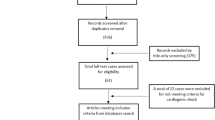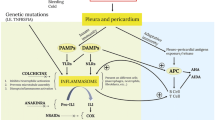Abstract
The aims of this study were to look for clinical or serological markers able to predict the use of biological disease-modifying anti-rheumatic drugs (bDMARDs) in patients with adult-onset Still’s disease (AOSD) and to evaluate the efficacy and safety of bDMARDs in AOSD. In a single-center retrospective study, 39 patients with AOSD were divided into two groups according to whether they were ever treated with bDMARDs or not. Literature was searched for articles dealing with possible predictors of the use of bDMARDs in AOSD. Among the 18 AOSD patients who received at least one bDMARD, the prevalence of pericarditis was higher than that in the other patients [p = 0.014, odds ratio (OR) = 13.4, 95 % confidence interval (CI) = 1.45 to 122]. Literature search retrieved another paper dealing with predictors of bDMARDs need in AOSD: the analysis pooling data from our series and this previous report confirmed pericarditis at disease onset as a predictor of bDMARDs need (p = 0.028, OR = 3.62, 95 % CI = 1.22 to 10.7). A complete remission was observed in 17 out of 18 patients treated with bDMARDs, allowing withdrawal or tapering of corticosteroid therapy (p < 0.001), but because of inefficacy or adverse events, some patients received more than one bDMARD during the course of the disease and 31 different trials of bDMARDs were needed. Pericarditis at disease onset may be a predictor of bDMARDs need in AOSD. These drugs have a good efficacy and safety profile and should be considered for patients not responding to conventional therapy.

Similar content being viewed by others
References
Efthimiou P, Paik PK, Bielory L (2006) Diagnosis and management of adult onset Still’s disease. Ann Rheum Dis 65:564–572
Fautrel B (2008) Adult-onset Still disease. Best Pract Res Clin Rheumatol 22:773–792
Masters SL, Simon A, Aksentijevich I, Kastner DL (2009) Horror autoinflammaticus: the molecular pathophysiology of autoinflammatory disease. Annu Rev Immunol 27:621–668
Rossi-Semerano L, Koné-Paut I (2012) Is Still’s disease an autoinflammatory syndrome? Int J Inflam 2012:480373
Rigante D, Cantarini L (2014) The systemic-onset variant of juvenile idiopathic arthritis needs to be recorded as an autoinflammatory syndrome: comment on the review by Nigrovic. Arthritis Rheumatol 66:2645
Maria AT, Le Quellec A, Jorgensen C, Touitou I, Rivière S, Guilpain P (2014) Adult onset Still’s disease (AOSD) in the era of biologic therapies: dichotomous view for cytokine and clinical expressions. Autoimmun Rev 13:1149–1159
Cavalli G, Franchini S, Aiello P et al (2015) Efficacy and safety of biological agents in adult-onset Still’s disease. Scand J Rheumatol 44:309–314
Kadavath S, Efthimiou P (2015) Adult-onset Still’s disease-pathogenesis, clinical manifestations, and new treatment options. Ann Med 47:6–14
Yamaguchi M, Ohta A, Tsunematsu T et al (1992) Preliminary criteria for classification of adult Still’s disease. J Rheumatol 19:424–430
Rau M, Schiller M, Krienke S, Heyder P, Lorenz H, Blank N (2010) Clinical manifestations but not cytokine profiles differentiate adult-onset Still’s disease and sepsis. J Rheumatol 37:2369–2376
Quartuccio L, Salvin S, Zuliani F, Mansutti E, De Vita S (2012) Pleuritis is a red flag for adult-onset Still’s disease which may require biologic therapies. Clin Exp Rheumatol 30:807
Henter JI, Horne A, Aricó M et al (2007) HLH-2004: diagnostic and therapeutic guidelines for hemophagocytic lymphohistiocytosis. Pediatr Blood Cancer 48:124–131
Franchini S, Dagna L, Salvo F, Aiello P, Baldissera E, Sabbadini MG (2010) Efficacy of traditional and biologic agents in different clinical phenotypes of adult-onset Still’s disease. Arthritis Rheum 62:2530–2535
Ortiz-Sanjuán F, Blanco R, Calvo-Rio V et al (2014) Efficacy of tocilizumab in conventional treatment-refractory adult-onset Still’s disease: multicenter retrospective open-label study of thirty-four patients. Arthritis Rheumatol 66:1659–1665
Nordström D, Knight A, Luukkainen R et al (2012) Beneficial effect of interleukin 1 inhibition with anakinra in adult-onset Still’s disease. An open, randomized, multicenter study. J Rheumatol 39:2008–2011
Colafrancesco S, Priori R, Valesini G (2015) Presentation and diagnosis of adult-onset Still’s disease: the implications of current and emerging markers in overcoming the diagnostic challenge. Expert Rev Clin Immunol 11:749–761
Parvez N, Carpenter JL (2009) Cardiac tamponade in Still disease: a review of the literature. South Med J 102:832–837
Cantarini L, Lopalco G, Selmi C et al (2015) Autoimmunity and autoinflammation as the yin and yang of idiopathic recurrent acute pericarditis. Autoimmun Rev 14:90–97
Fitzgerald AA, Leclercq SA, Yan A, Homik JE, Dinarello CA (2005) Rapid responses to anakinra in patients with refractory adult-onset Still’s disease. Arthritis Rheum 52:1794–1803
Kalliolias GD, Georgiou PE, Antonopoulos IA, Andonopoulos AP, Liossis SN (2007) Anakinra treatment in patients with adult-onset Still’s disease is fast, effective, safe and steroid sparing: experience from an uncontrolled trial. Ann Rheum Dis 66:842–843
Ortiz-Sanjuán F, Blanco R, Riancho-Zarrabeitia L et al (2015) Efficacy of anakinra in refractory adult-onset Still’s disease: multicenter study of 41 patients and literature review. Medicine (Baltimore) 94(39):e1554
Giampietro C, Ridene M, Lequerre T et al (2013) Anakinra in adult-onset Still’s disease: long-term treatment in patients resistant to conventional therapy. Arthritis Care Res (Hoboken) 65:822–826
Hong D, Yang Z, Han S et al (2014) Interleukin 1 inhibition with anakinra in adult-onset Still disease: a meta-analysis of its efficacy and safety. Drug Des Devel Ther 8:2345–2357
Puechal X, deBandt M, Berthelot JM, Breban M, Dubost JJ, Fain O et al (2011) Tocilizumab in refractory adult Still’s disease. Arthritis Care Res (Hoboken) 63:155–159
De Boysson H, Fevrier J, Nicolle A, Auzary C, Geffray L (2013) Tocilizumab in the treatment of the adult-onset Still’s disease: current clinical evidence. Clin Rheumatol 32:141–147
Acknowledgments
None.
Author information
Authors and Affiliations
Corresponding author
Ethics declarations
Disclosures
None.
Rights and permissions
About this article
Cite this article
Dall’Ara, F., Frassi, M., Tincani, A. et al. A retrospective study of patients with adult-onset Still’s disease: is pericarditis a possible predictor for biological disease-modifying anti-rheumatic drugs need?. Clin Rheumatol 35, 2117–2123 (2016). https://doi.org/10.1007/s10067-015-3164-y
Received:
Revised:
Accepted:
Published:
Issue Date:
DOI: https://doi.org/10.1007/s10067-015-3164-y




